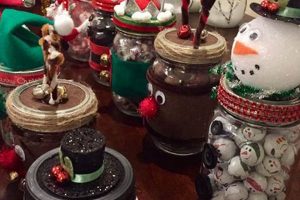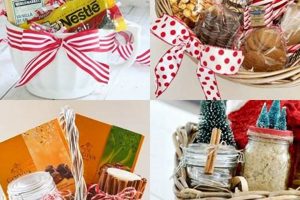Handcrafted presents constructed from timber, designed for the holiday season, represent a thoughtful and personalized alternative to commercially produced items. Such items encompass a broad spectrum, ranging from decorative ornaments and kitchenware to toys and personalized home decor. Examples include carved wooden snowflakes, custom-engraved cutting boards, and hand-painted wooden toy figures.
The creation and presentation of these handcrafted items offers multiple advantages. This process encourages resourcefulness and creative expression, resulting in unique gifts imbued with personal significance. The use of natural materials aligns with environmentally conscious practices, promoting sustainable gifting. Furthermore, such activity can foster intergenerational engagement through shared crafting experiences and the preservation of traditional skills.
The subsequent sections will delve into specific project ideas, provide guidance on wood selection and finishing techniques, and offer safety recommendations for constructing presents suitable for festive giving.
Crafting Quality Timber Presents
The creation of durable and aesthetically pleasing wooden gifts requires careful consideration of several factors. The following guidelines will assist in achieving professional results when constructing handmade presents.
Tip 1: Material Selection: Choose wood appropriate for the intended use. Hardwoods, such as maple or oak, offer durability for frequently used items like cutting boards. Softwoods, like pine, are suitable for decorative pieces or items requiring easy carving.
Tip 2: Precise Measurement and Cutting: Accurate measurements and clean cuts are essential for a professional finish. Employ precision measuring tools and sharp blades. Utilize jigs or guides when replicating identical components.
Tip 3: Secure Joinery Techniques: Implement strong joinery methods, such as mortise and tenon, dovetails, or dowels, to ensure structural integrity. Wood glue, appropriate for the selected wood type, should be applied liberally to all joining surfaces.
Tip 4: Sanding and Surface Preparation: Thorough sanding is critical for a smooth, professional finish. Progress through multiple grits of sandpaper, starting with coarser grits to remove imperfections and ending with finer grits for a polished surface.
Tip 5: Finishing Application: Select a finish that complements the wood type and project purpose. Options include varnish, lacquer, polyurethane, or natural oils. Apply thin, even coats, allowing adequate drying time between applications.
Tip 6: Personalization with Care: Engraving, painting, or staining can add a personal touch. However, execute these techniques with precision and attention to detail. Practice on scrap wood before applying to the final piece.
Tip 7: Prioritize Safety: Wear appropriate safety gear, including eye protection, hearing protection, and a dust mask, when operating power tools or applying finishes. Work in a well-ventilated area to minimize exposure to harmful fumes.
By adhering to these guidelines, craftspeople can produce high-quality wooden gifts that are both aesthetically pleasing and structurally sound. Careful planning, precise execution, and attention to detail will result in cherished items that reflect the time and effort invested.
The subsequent section will address specific project ideas and explore advanced techniques for elevated craftsmanship.
1. Wood Selection
The choice of wood exerts a direct influence on the aesthetic appeal, structural integrity, and longevity of timber holiday presents. Inadequate material selection can compromise the final product, leading to premature failure or diminished visual impact. For example, utilizing a softwood like pine for a cutting board destined for frequent use will result in unsightly knife marks and potential warping, rendering the gift less functional and aesthetically pleasing. Conversely, selecting a hardwood like maple provides a durable, resilient surface suitable for repeated cutting and washing. Similarly, the character of the wood’s grain impacts the visual character. A highly figured wood like walnut, while visually stunning, may necessitate more advanced woodworking techniques to ensure proper finishing and structural stability in complex projects, like wooden boxes or intricate ornaments.
Considerations beyond durability and aesthetics include the wood’s workability and sustainability. Certain hardwoods are notoriously difficult to work with using hand tools, demanding specialized equipment or greater physical exertion. Sourcing wood from sustainable forests demonstrates environmental responsibility, aligning with ethical gifting practices. For instance, purchasing lumber from a certified sustainable source ensures that the timber was harvested responsibly, minimizing environmental impact. Local wood species can also add regional character to holiday presents, strengthening their personal connection.
In conclusion, informed decision-making in wood selection is paramount to the successful creation of quality handcrafted holiday presents. Understanding the properties of different wood species, considering the project’s intended use, and prioritizing sustainable sourcing practices will enhance both the longevity and sentimental value of the resulting gift, leading to increased satisfaction for both the maker and the recipient.
2. Project Design
Effective project design is a critical determinant in the successful creation of handcrafted timber presents intended for the holiday season. Meticulous planning, encompassing both aesthetic and functional considerations, directly influences the final product’s quality and recipient satisfaction. Absent a well-defined design, the resulting item may lack structural integrity, visual appeal, or practical utility.
- Conceptualization and Planning
The initial stage involves defining the gift’s purpose, target recipient, and desired aesthetic. This includes sketching preliminary designs, selecting appropriate dimensions, and identifying necessary components. For example, a poorly conceptualized wooden toy may present safety hazards due to sharp edges or small, detachable parts. Conversely, a well-planned design considers these factors, ensuring the toy’s safety and durability.
- Material Optimization
Project design necessitates a careful assessment of material usage to minimize waste and maximize the inherent qualities of the selected wood. Efficient nesting of parts during layout reduces material consumption and associated costs. Furthermore, the design should account for the wood’s grain orientation to enhance structural strength and aesthetic appeal. A design that ignores grain direction may result in warping or cracking over time.
- Structural Integrity and Functionality
A robust project design prioritizes structural stability and intended functionality. This involves selecting appropriate joinery techniques, such as mortise and tenon or dovetail joints, to withstand anticipated stresses. The design must also consider the gift’s intended purpose. For instance, a wooden spice rack requires a design that securely holds spice containers and provides easy access to contents.
- Aesthetic Considerations
Beyond functionality, project design also encompasses visual elements that contribute to the gift’s overall appeal. This includes the selection of appropriate surface finishes, decorative elements, and ergonomic considerations. A well-designed wooden picture frame, for example, complements the photograph it contains and integrates seamlessly with the surrounding decor. Conversely, a poorly designed frame may detract from the photograph’s aesthetic impact.
In conclusion, well-conceived project design is the foundation of successful timber holiday presents. A comprehensive design process, integrating conceptualization, material optimization, structural considerations, and aesthetic elements, ensures the creation of gifts that are both aesthetically pleasing and functionally sound, thereby maximizing recipient satisfaction and reflecting the thoughtfulness invested in their creation.
3. Tool Proficiency
The successful creation of handcrafted holiday gifts from wood is inextricably linked to the maker’s proficiency in utilizing woodworking tools. The level of skill directly influences the precision, quality, and overall success of each project. Inadequate tool handling skills can result in inaccurate cuts, compromised joinery, and potential safety hazards.
- Hand Tool Mastery
Proficiency with hand tools, such as saws, chisels, and planes, enables the creation of intricate details and precise joinery. Consider a delicately carved wooden ornament. The fine details and smooth surfaces achievable with sharp chisels and well-tuned planes are often unmatched by power tools. Inability to accurately use these hand tools results in rough edges, ill-fitting joints, and a diminished aesthetic quality.
- Power Tool Competence
Safe and accurate operation of power tools, including table saws, routers, and sanders, facilitates efficiency and consistency in larger projects or tasks involving repetitive cuts. Building a wooden toy chest, for example, requires precise and repeatable cuts for the various components. A lack of proficiency with these tools can lead to inaccurate dimensions, uneven surfaces, and potential injury.
- Sharpening and Maintenance
Maintaining sharp cutting edges on both hand and power tool blades is essential for efficient and safe woodworking. Dull tools require more force to operate, increasing the risk of slippage and injury. Furthermore, dull blades produce rough cuts, requiring additional sanding and compromising the overall quality of the final product. Regular sharpening and proper maintenance ensures optimal performance and longevity of the tools.
- Safety Protocol Adherence
Consistent adherence to established safety protocols is paramount when working with woodworking tools. This includes wearing appropriate safety gear, such as eye protection and hearing protection, and understanding the specific hazards associated with each tool. Failure to follow safety guidelines can result in serious injury, rendering project completion impossible and potentially causing long-term health consequences.
Consequently, cultivating proficiency in woodworking tools, encompassing both hand and power tools, proper maintenance practices, and unwavering adherence to safety protocols, is a prerequisite for creating high-quality, aesthetically pleasing, and safe timber holiday gifts. The level of skill directly translates to the final product’s quality and reflects the maker’s dedication and craftsmanship.
4. Finishing Techniques
The application of appropriate finishing techniques significantly impacts the visual appeal, durability, and longevity of handcrafted timber presents crafted for the holiday season. The selection and execution of these techniques are directly causal to the gift’s perceived quality and its ability to withstand environmental factors and regular use. Absent a suitable finish, the wood is vulnerable to moisture damage, scratches, and discoloration, diminishing its aesthetic value and lifespan. For example, a wooden toy left unfinished would quickly absorb dirt and moisture, becoming unsanitary and susceptible to warping or cracking. Conversely, the application of a durable, non-toxic finish, such as beeswax or shellac, protects the wood, enhances its natural grain, and provides a safe, aesthetically pleasing surface for children to handle.
The choice of finish depends on the wood species, the intended use of the gift, and the desired aesthetic. Oil-based finishes, such as linseed oil or tung oil, penetrate the wood, enhancing its natural color and providing a soft, matte finish. These finishes are well-suited for items requiring minimal maintenance, like wooden ornaments or decorative boxes. Film-forming finishes, such as varnish or lacquer, create a protective layer on the wood’s surface, offering greater resistance to scratches and water damage. These finishes are appropriate for items subject to frequent use, such as cutting boards or serving trays. The application method also affects the final result; improper sanding or uneven application can result in blemishes or an uneven sheen. A poorly applied finish detracts from the craftsmanship and reduces the overall value of the gift.
In summation, finishing techniques are a crucial component in the creation of quality handcrafted timber presents. Selecting the appropriate finish, preparing the wood surface meticulously, and applying the finish with care contribute significantly to the gift’s aesthetic appeal, durability, and overall value. Ignoring this aspect compromises the final product, reducing its lifespan and diminishing the recipient’s appreciation. Mastery of finishing techniques is therefore essential for any craftsperson seeking to create cherished and long-lasting timber gifts.
5. Personalization Options
The integration of personalization options significantly enhances the value and sentimentality of timber holiday gifts. The ability to tailor a handcrafted item to a specific individual transforms a generic present into a unique and cherished keepsake. Consider, for example, a wooden picture frame. A mass-produced frame offers a functional purpose, but lacks personal connection. However, the addition of laser-engraved initials, a meaningful date, or a personal quote elevates the frame to a personalized emblem of shared memories. The act of customization indicates a thoughtful consideration of the recipient’s preferences and personality, strengthening the emotional bond associated with the gift. The lack of personalization renders the gift less meaningful, reducing its impact and perceived value.
Various methods facilitate personalization in timber holiday gift creation. Engraving, either by hand or with a laser, enables the addition of text, symbols, or intricate designs to the wood surface. Painting and staining allow for the incorporation of specific colors and patterns, aligning the gift with the recipient’s aesthetic preferences. Wood burning, also known as pyrography, provides a rustic and artistic means of adding personalized details. Furthermore, incorporating unique hardware, such as custom-designed knobs or handles, can subtly enhance the gift’s personalization. For instance, a wooden jewelry box customized with the recipient’s favorite flower engraved on the lid and lined with their preferred color fabric demonstrates a profound level of thoughtfulness and attention to detail. The act of personalization creates a tangible representation of the giver’s care and consideration, fostering a deeper appreciation for the gift.
Effective utilization of personalization options demands careful planning and execution. The chosen personalization method should complement the wood type and the overall design of the gift. Subtlety and restraint often enhance the impact of personalization; excessive or poorly executed customization can detract from the gift’s aesthetic appeal. The ultimate goal of personalization is to create a unique and meaningful item that resonates with the recipient, fostering a lasting connection and enhancing the perceived value of the handcrafted holiday present.
Frequently Asked Questions
The following section addresses common inquiries regarding the creation and selection of handcrafted timber presents appropriate for holiday gifting.
Question 1: What types of wood are most suitable for cutting boards?
Dense hardwoods, such as maple, cherry, and walnut, are generally recommended for cutting boards due to their durability, resistance to bacteria, and ability to withstand repeated washing. Avoid softwoods like pine, which are prone to scratching and warping.
Question 2: What safety precautions should be observed when using power tools?
Eye protection, hearing protection, and a dust mask are essential when operating power tools. Ensure adequate lighting and ventilation. Familiarize oneself with the tool’s operating manual and safety features before use. Never operate power tools while fatigued or under the influence of substances.
Question 3: How can wood warping be prevented?
Proper wood storage is crucial. Store lumber in a dry, well-ventilated area away from direct sunlight and extreme temperature fluctuations. Apply a consistent finish to all surfaces of the wood to minimize moisture absorption. Utilize appropriate joinery techniques to ensure structural stability.
Question 4: What are some non-toxic finish options for wooden toys?
Several non-toxic finish options are available for wooden toys, including beeswax, shellac, and milk paint. Ensure that the chosen finish is specifically labeled as non-toxic and suitable for use on children’s products. Follow the manufacturer’s instructions for application and drying times.
Question 5: How can personalized engravings be achieved on wood?
Personalized engravings can be achieved through various methods, including hand carving, wood burning (pyrography), and laser engraving. Laser engraving offers the highest level of precision and detail. Hand carving requires skill and practice. Wood burning provides a rustic aesthetic.
Question 6: What are the environmental considerations when sourcing wood?
Prioritize sourcing wood from sustainably managed forests certified by organizations like the Forest Stewardship Council (FSC). Consider using reclaimed or recycled wood to reduce demand for newly harvested timber. Local wood species can minimize transportation emissions.
The answers provided offer general guidance; specific circumstances may warrant consultation with woodworking professionals.
The subsequent section will explore advanced techniques for enriching the craft of making memorable timber gifts.
diy wood christmas gifts
The preceding exploration of “diy wood christmas gifts” has illuminated various facets of the craft, emphasizing material selection, project design, tool proficiency, finishing techniques, and personalization options. The creation of quality, handcrafted holiday presents from timber requires a holistic understanding of these principles. Inadequate attention to any single element can compromise the final product, diminishing its aesthetic appeal, structural integrity, or sentimental value.
The information presented serves as a foundation for informed decision-making and skillful execution. Craftspeople are encouraged to consider the ethical dimensions of material sourcing, prioritizing sustainable practices and minimizing environmental impact. As the demand for personalized and meaningful gifts continues to grow, the art of creating handcrafted wooden presents offers a powerful means of fostering connection, expressing creativity, and celebrating the spirit of the holiday season.







![Unique DIY Gifts Dad Christmas Ideas [Handmade!] The DIY Hub: Creative Crafts, Repairs & Life Hacks Unique DIY Gifts Dad Christmas Ideas [Handmade!] | The DIY Hub: Creative Crafts, Repairs & Life Hacks](https://craftingdiycenter.com/wp-content/uploads/2025/07/th-3806-300x200.jpg)